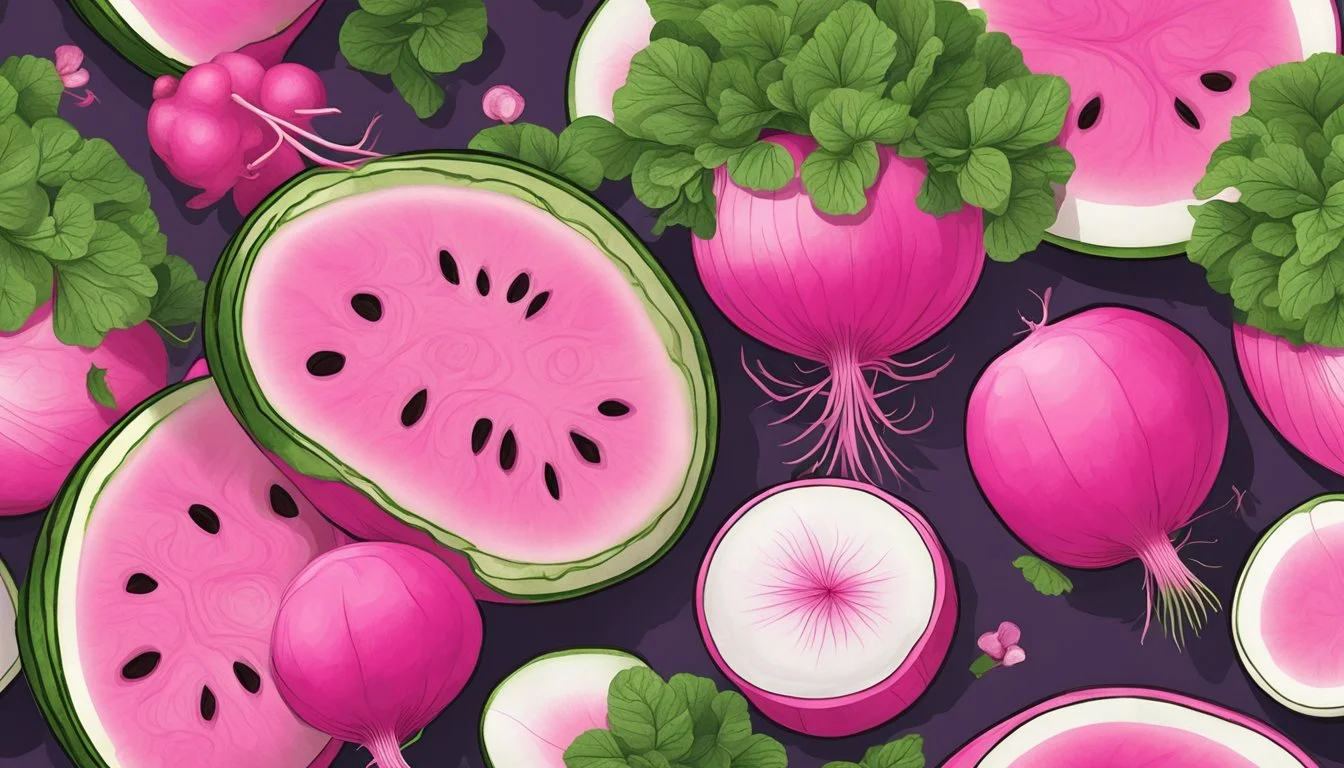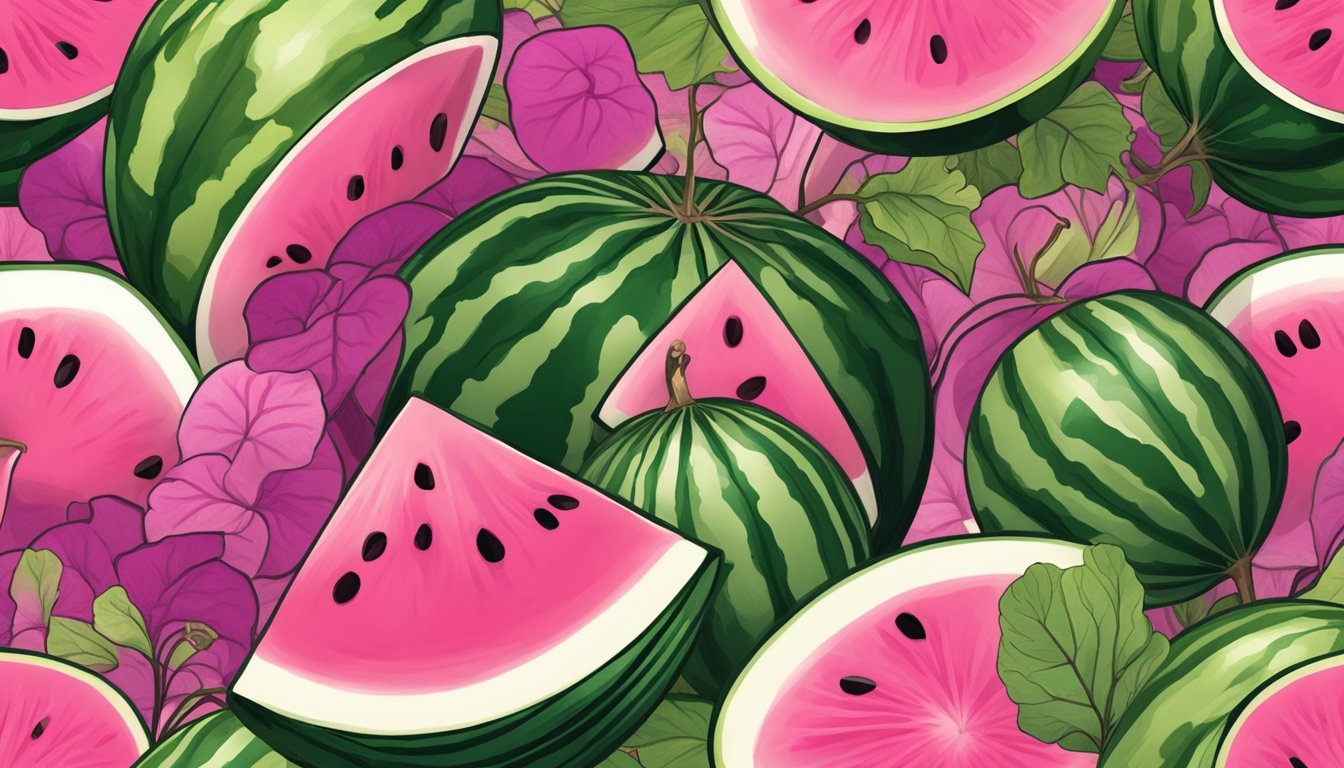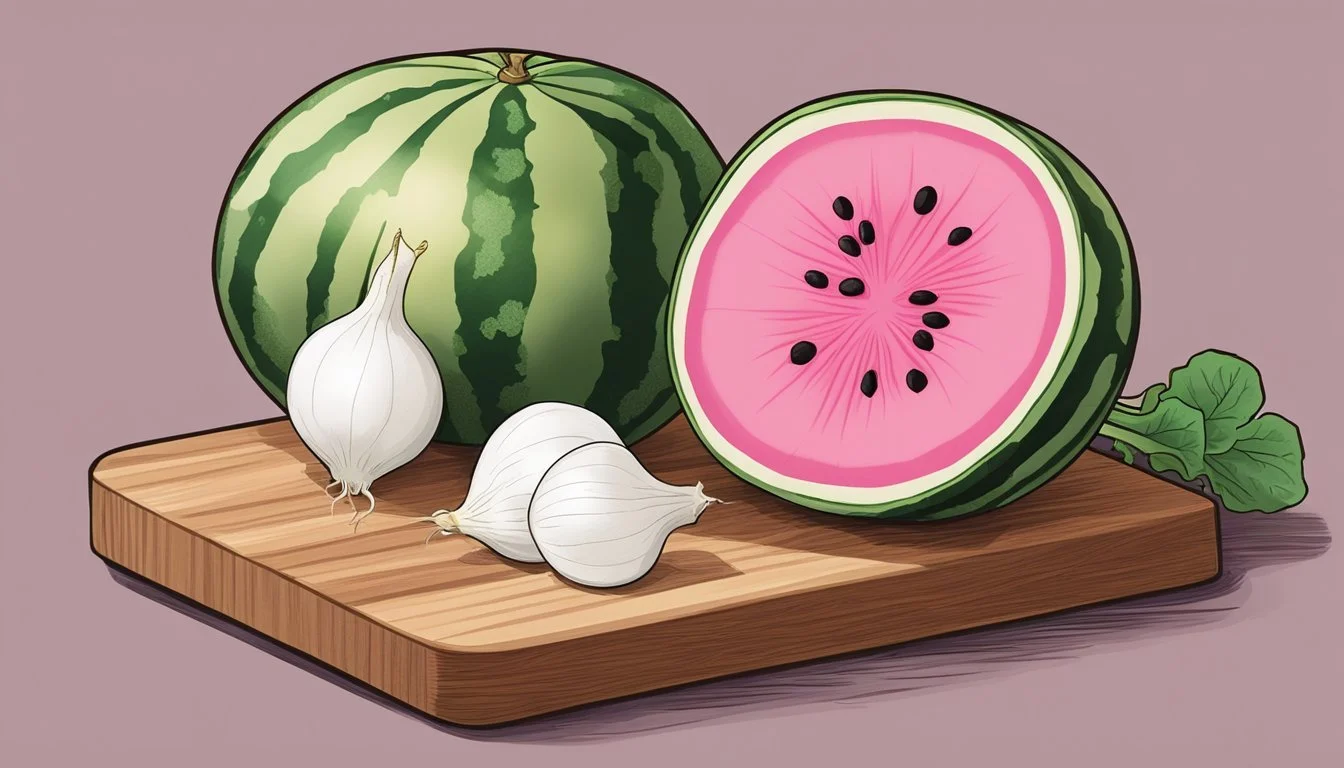How to Substitute Watermelon Radish for Daikon Radish
A Simple Switch Guide
Watermelon radish, known for its striking appearance and mild, slightly peppery taste, can be a suitable substitute for daikon radish in many culinary applications. While daikon radishes are long, white, and have a milder flavor, they share the crisp texture of watermelon radishes, making them interchangeable in recipes that require a crunchy component. Chefs and home cooks alike can achieve a comparable result by applying a simple substitution method which retains the dish's integrity.
Cooking enthusiasts who wish to incorporate watermelon radish as an alternative can do so with confidence. The key to a successful substitution lies in understanding the subtle flavor profile and adjusting the quantity to match the size difference between the two. Watermelon radishes are typically smaller and can vary in spice levels compared to the gentle tang of daikon radishes. The visual appeal of watermelon radish, with its green exterior and vibrant pink interior, also adds an unexpected pop of color to dishes.
Understanding Radishes
When substituting watermelon radish for daikon radish, it's essential to understand the distinct characteristics of radishes. They vary widely in flavor, nutritional content, and culinary uses.
Radish Varieties
The radish, a root vegetable in the Brassicaceae family, comes in various shapes, sizes, and colors. Two noteworthy varieties include:
Daikon Radish: Originating from Asia, the daikon radish is a long, white root vegetable known for its mild flavor and crunchy texture.
Watermelon Radish: Named for its resemblance to a watermelon with its green exterior and vibrant pink interior, the watermelon radish offers a slightly sweet and earthy flavor.
Flavor Profiles
The flavor of radishes ranges from mild to peppery, each complementing different dishes:
Daikon Radish: It’s appreciated for its mild flavor that does not overpower other ingredients.
Watermelon Radish: Exhibits a mild to slightly sweet flavor, making it adaptable for a variety of culinary applications.
A radish's flavor can also change depending on how it is prepared. Cooking typically softens the flavor and increases sweetness, whereas raw radishes provide a crisper, more pronounced taste.
Nutritional Value
Radishes offer an array of nutritional benefits and are generally low in calories. They contain:
Fiber: Essential for digestive health.
Vitamin C: Supports the immune system and provides antioxidant properties.
Minerals: Such as potassium and calcium.
Nutrient Daikon Radish Watermelon Radish Calories Low Low Fiber High High Vitamin C Good Source Good Source Minerals Contains potassium, some calcium Contains potassium, some calcium
In summary, whether utilizing daikon or watermelon radish, each variety contributes unique flavors and nutritional values to dishes.
Selecting a Substitute
When substituting watermelon radish for daikon radish, one must consider factors such as crunch factor, flavor, and visual appeal to ensure the integrity of the original dish is maintained.
Crunch Factor
A watermelon radish is known for its crisp texture. To replicate this crunch, suitable substitutes include red radishes and carrots. These vegetables match the desired texture and will provide the necessary bite in salads and slaws.
Red Radish
Texture: Crisp, firm
Substitute Ratio: 1 red radish = 1 watermelon radish
Carrots
Texture: Crunchy when raw
Substitute Ratio: Equal parts
Flavor Considerations
Daikon radishes possess a mild flavor with a hint of sweetness, often desired in a variety of dishes. The following substitutions can preserve the sweet and mild nuances:
Turnips
Flavor: Mildly sweet when raw, sweeter when cooked
Substitute Ratio: Equal parts
Korean Radish
Flavor: Slightly peppery with sweet overtones
Substitute Ratio: 1 Korean radish = 1 watermelon radish
Color and Presentation
The visual aspect of watermelon radish, with its vibrant color, contributes significantly to the presentation of a dish. To mimic this:
Red Radish
Color: Bright red skin
Substitute: Consider slicing thinly to simulate the colorful accent.
Black Radish
Color: Black exterior, white interior
Substitute: Use sparingly, as it can darken the presentation.
Preparation Methods
When substituting watermelon radish for daikon radish, one must consider the differences in texture and flavor intensity. The resilience of watermelon radish holds up well in both raw and cooked preparations, offering versatility in gastronomic applications.
Raw Preparation
Watermelon radishes are crisp and slightly peppery, which makes them an excellent choice for raw dishes. They excel in:
Salads: Thinly slice or use a mandoline to incorporate into salads for a crunchy element.
Sandwiches: Add a few matchsticks or thin slices for a spicy-sweet crunch.
Pickled: Combine with vinegar, water, sugar, and salt to create quick pickles.
These techniques enhance the radish's natural attributes without overwhelming other ingredients in the dish.
Cooking Techniques
In their cooked form, watermelon radishes mellow out, yet retain a firm texture. They adapt well to various methods, such as:
Roasted: Toss with oil, salt, and pepper, and roast at 425°F until tender. This process caramelizes the radish's exterior and softens the interior.
Steamed: Steam halves or quarters until they are just tender to maintain some crunch.
Sautéed: Thinly slice and sauté quickly over high heat for a tender-crisp addition to dishes.
Soups and Stews (What wine goes well with stews?): Cut into chunks and add to soups or stews, where they behave similarly to turnips.
These techniques offer a softer texture and a more subdued flavor to suit a variety of dishes.
Recipes and Uses
In incorporating daikon radish in place of watermelon radish, the culinary possibilities are extensive and inspired by varied cuisines. Both radishes afford a similar crisp texture; however, daikon lends a milder flavor, often preferred for balancing the tastes in diverse dishes.
Salads and Slaw
In salads, daikon radish serves as a crunchy, slightly peppery addition. It’s perfect for an Asian slaw, where it can be julienned and mixed with carrots, cabbage, and a tangy dressing. The radish's consistency holds up well, making it a fitting ingredient for both fresh and marinated salads.
Asian Slaw: Julienned daikon, carrots, green cabbage, dressed in rice vinegar and sesame oil.
Taco Toppings: Thinly sliced daikon, cilantro, and a squeeze of lime juice, paired with fish or carnitas tacos.
Soups and Stews
For soups and stews, daikon radish can be cubed or sliced into half-moons and added in a similar manner as carrots. They impart a subtle sweetness and absorb flavors from broths and seasonings. One could introduce them to Asian-inspired soups for a nutritious boost.
Miso Soup: Sliced daikon simmered in dashi broth, complemented by tofu and seaweed.
Beef Stew: Cubed daikon added alongside chunks of beef, enriching the stew with a soft texture once cooked.
Side Dishes
As a side dish, daikon radish is versatile. It can be roasted to bring out its inherent sweetness or pickled for a tangy condiment to accompany main dishes. In Korean cuisine, daikon radish is often fermented to make kimchi, offering a delectable side dish full of flavor.
Roasted Daikon: Seasoned with herbs and roasted until golden.
Pickled Daikon: Sliced daikon pickled in a mixture of vinegar, sugar, and salt, served as a garnish or condiment.
Health and Nutrition
Substituting watermelon radish for daikon radish in recipes offers notable health and nutrition benefits. Both radishes are inherently low in calories and are packed with vital nutrients, such as fiber, vitamins, and minerals, which support overall digestive health and provide a nutritional boost.
Digestive Benefits
Watermelon and daikon radishes both contain a significant amount of dietary fiber, which is essential for digestive health. Fiber helps to regulate the digestive system, preventing constipation and promoting regular bowel movements.
Fiber content comparison:
Watermelon radish: 1.9g per 100g
Daikon radish: 2.5g per 100g
Due to their high water content, particularly in daikon radish at 93 grams per 100 grams, they support hydration, which is also crucial for digestion.
Vitamin and Mineral Boost
Radishes are known for their vitamin and mineral profiles. While both the watermelon and daikon radishes are similar in nutritional composition, there are differences to highlight.
Key nutrients in Daikon radish:
Vitamin C: Boosts immunity and skin health
Potassium: Important for heart and muscle function
Calcium: Essential for bone health
Daikon radish nutrient profile (per 100g):
Vitamin C: 22mg
Potassium: 227mg
Calcium: 27mg
In contrast, watermelon radishes also deliver vitamins and minerals, which makes them an excellent substitute while still maintaining a nutritional profile that supports overall health.
Shopping and Storage
When substituting watermelon radish for daikon radish, it's essential to select radishes that epitomize freshness and to understand proper storage techniques to maintain that freshness.
Selecting Fresh Radishes
Watermelon radish:
Appearance: Look for radishes with a firm texture and vibrant green leaves. The skin should be smooth without cracks or blemishes.
Freshness indicator: The radish should feel heavy for its size, indicating adequate water content.
Red radishes:
Seasonality: Although available year-round, they are best in spring and early summer.
Size: Smaller radishes tend to be more tender and less pungent.
White radish:
Often referred to as a type of winter radish due to its availability in colder months.
Choose white radishes that are firm to the touch and free from soft spots.
Storing for Freshness
Watermelon radish:
Temperature: Store them in the crisper drawer of the refrigerator.
Humidity: Wrap in a damp cloth or paper towel and place them in a perforated plastic bag to maintain moisture.
Red and white radishes:
Before storing: Remove leafy greens to prevent the radishes from losing moisture and becoming soft.
Shelf life: They can typically be stored for about a week, ensuring their crispness and flavor.
By adhering to these guidelines, individuals can ensure their radishes retain their best qualities until ready to be used in recipes requiring daikon radish.
Alternative Ingredients
When substituting daikon radish for watermelon radish, various vegetables offer similar textures and flavors suitable for diverse recipes.
Top Daikon Radish Substitutes
Horseradish: This pungent root can mimic daikon's sharpness. It's advisable to mix horseradish with salt and vinegar for a balanced substitute.
Jicama: Known for its crunchy texture, jicama serves as a refreshing stand-in, especially in salads and slaws.
Korean Radish (Mu): Slightly sweeter than daikon, this can be used in equal proportions.
Black Spanish Radish: With its firm texture, it provides a good contrast to softer ingredients in a dish.
Exploring Other Vegetables
White Turnips: Their crispness and mild flavor make them an excellent alternative.
Parsnips: Similar to carrots, parsnips offer a slightly sweet taste and can be eaten raw or cooked.
Carrots: They add color and crunch, though sweeter than daikon.
Water Chestnuts: Best used fresh, they add a crisp texture to salads.
Creative Substituting
Winter Vegetables: Examples include rutabaga and kohlrabi, which hold up well in cooking and add robustness to meals.
Beetroot and Cabbage: These can be julienned for a colorful and textural addition to dishes.
Cucumbers: While not a direct substitute in terms of texture, cucumbers can be used in uncooked preparations for a refreshing crunch.







